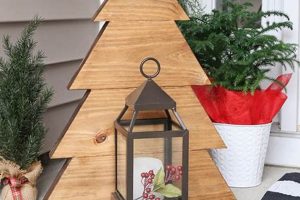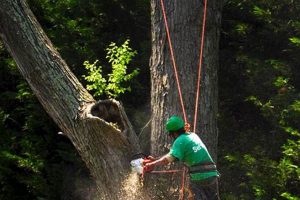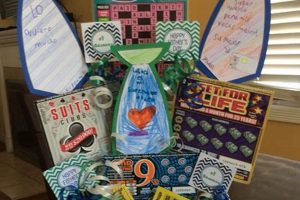Creating visually appealing table decorations on a limited budget is achievable through resourcefulness and readily available materials. These decorative elements, often constructed from inexpensive items sourced from discount retailers, offer an accessible way to enhance the ambiance of events ranging from casual gatherings to formal celebrations. For example, a vase filled with faux floral stems and decorative stones, all purchased at a single low-cost store, can serve as a simple yet elegant focal point.
The practice of crafting economical decorative pieces provides numerous advantages. It allows for significant cost savings compared to purchasing pre-made arrangements, grants greater creative control over the aesthetic, and promotes sustainable practices by repurposing or upcycling materials. Historically, individuals have sought affordable methods for event decoration, leading to the evolution of do-it-yourself approaches utilizing accessible and budget-friendly resources.
The following discussion will explore various techniques and ideas for constructing affordable and aesthetically pleasing table decorations. Specific material suggestions and step-by-step instructions will be provided to facilitate the creation of customized centerpieces for diverse occasions, all while adhering to budgetary constraints.
Tips for Economical Table Decorations
The following recommendations offer practical guidance for constructing affordable and visually appealing table centerpieces, emphasizing resourcefulness and cost-effectiveness.
Tip 1: Prioritize Planning. Before purchasing materials, determine the desired aesthetic and overall theme. A well-defined plan prevents impulse buys and ensures cohesive design.
Tip 2: Embrace Faux Florals. Artificial flowers offer a cost-effective and durable alternative to fresh blooms. Select realistic-looking varieties and consider mixing different textures and colors for visual interest.
Tip 3: Utilize Glassware Creatively. Simple glass containers, such as vases, bowls, or jars, can be transformed into elegant centerpieces with the addition of decorative fillers like stones, beads, or water beads.
Tip 4: Incorporate Candles for Ambiance. Candles, both real and LED, create a warm and inviting atmosphere. Group multiple candles of varying heights for a visually dynamic arrangement.
Tip 5: Repurpose and Upcycle. Explore opportunities to repurpose existing household items or upcycle materials into unique centerpiece components. This reduces costs and promotes sustainability.
Tip 6: Consider Seasonal Elements. Incorporating seasonal items, such as pinecones in winter or pumpkins in autumn, adds a thematic touch and can often be obtained at low cost.
Tip 7: Focus on Visual Balance. Ensure that the centerpiece is appropriately sized for the table and does not obstruct views. Strive for visual balance in terms of color, texture, and height.
Implementing these strategies can significantly reduce the cost of table decorations without compromising aesthetic appeal. Creative resourcefulness and careful planning are key to achieving impactful results on a limited budget.
The subsequent section will address common challenges encountered during the creation of affordable centerpieces and offer practical solutions for overcoming these obstacles.
1. Affordability
Affordability constitutes a foundational element in the pursuit of do-it-yourself table decorations utilizing resources from discount retailers. This financial consideration dictates the selection of materials, design complexity, and overall project scope. Its significance lies in enabling individuals to achieve aesthetically pleasing results without incurring substantial expenditure.
- Material Cost Reduction
Prioritizing low-cost materials is paramount. This involves substituting expensive elements, such as fresh flowers, with affordable alternatives like artificial blooms or repurposed items. Selecting cost-effective base components, such as vases or containers, from budget-friendly sources directly impacts overall expenses.
- Simplified Design Implementation
Complex designs often necessitate specialized materials and advanced crafting skills, leading to increased costs. Affordability encourages simplified designs that can be executed with readily available tools and minimal technical expertise. This focus on simplicity streamlines the construction process and reduces the potential for errors or waste.
- Budget-Conscious Resource Allocation
Adhering to a predetermined budget necessitates careful resource allocation. This involves identifying essential components and prioritizing their acquisition based on cost-effectiveness. Discretionary elements, such as elaborate embellishments, are often minimized or eliminated to ensure that core design objectives are met within budgetary constraints.
- Accessibility for Diverse Events
Creating economical decorations is often applied for diverse events such as wedding or birthday party. In order to keep in budget, individuals have to ensure materials bought is affordable and accesible that everyone can follow through and DIY the table decorations.
The facets of material cost reduction, simplified design implementation, and budget-conscious resource allocation collectively contribute to the feasibility of constructing visually appealing centerpieces within defined financial parameters. This approach extends accessibility, enabling individuals to enhance event aesthetics without overextending their budgetary resources.
2. Creative Resourcefulness
Creative resourcefulness is a pivotal element when constructing inexpensive do-it-yourself table decorations using materials from discount retailers. It bridges the gap between limited financial resources and the desire for aesthetically pleasing event dcor. The absence of expansive budgets necessitates innovative thinking and the ability to repurpose or reimagine readily available items. For example, utilizing glass pebbles meant for vase filling to create a mosaic base for a candle, or transforming picture frames into elegant stands, showcases such ingenuity.
The importance of creative resourcefulness extends beyond mere cost savings. It fosters a personalized approach to dcor, resulting in unique and often more meaningful arrangements. Instead of purchasing mass-produced items, individuals are empowered to create centerpieces that reflect their personal style and the theme of the event. Consider the use of simple twine and wooden dowels, transformed into miniature trees or geometric structures, demonstrating the capacity to elevate ordinary materials into sophisticated design elements. Furthermore, creative resourcefulness often encourages sustainability by utilizing recycled or upcycled components, aligning with environmentally conscious practices.
In summary, creative resourcefulness is not merely a cost-cutting measure but a catalyst for innovation and personalization in the realm of affordable dcor. It transforms the constraints of a limited budget into opportunities for ingenuity, allowing individuals to craft distinctive and impactful centerpieces. This approach, however, requires a shift in mindset viewing potential materials through a lens of possibility and embracing the challenge of transforming the ordinary into the extraordinary.
3. Material Versatility
Material versatility plays a crucial role in the creation of inexpensive do-it-yourself table centerpieces when sourcing materials from discount retailers. The capacity to adapt and utilize a range of materials beyond their intended purpose is fundamental to achieving cost-effective and aesthetically pleasing results. The inherent limitations imposed by budgetary constraints necessitate an innovative approach to material selection and application.
- Adaptability to Design Requirements
Material versatility enables the adaptation of available resources to meet diverse design requirements. For example, simple glass vases, initially intended for floral arrangements, can be repurposed as candle holders or decorative containers. Similarly, craft foam, typically used for children’s projects, can be shaped and painted to create intricate floral accents or geometric structures. This adaptability allows for the realization of varied design concepts within budgetary constraints.
- Expanded Creative Possibilities
A wide range of materials broadens the possibilities for unique centerpiece designs. Consider the combination of natural elements like pebbles or branches with manufactured items such as plastic gems or metallic accents. This fusion allows for visually interesting and texturally diverse compositions that elevate the overall aesthetic. Such creative blends demonstrate the power of materials in crafting personalized dcor.
- Cost Optimization through Substitution
Material versatility facilitates the substitution of expensive components with more affordable alternatives. For instance, silk flowers can replace fresh blooms, while acrylic crystals offer a comparable visual effect to genuine gemstones at a significantly reduced cost. The ability to make substitutions without compromising visual appeal is a key factor in maintaining affordability.
- Resource Maximization
By using a wide range of materials creatively, you can do more with fewer resources. This leads to minimizing waste and saving money, which ensures the maximization of resources. Creative utilization of different materials makes the centerpiece stand out from others.
The facets of adaptability to design requirements, expanded creative possibilities, and cost optimization through substitution collectively underscore the significance of material versatility in the construction of affordable do-it-yourself table centerpieces. This adaptability ensures that resourcefulness is maximized, allowing for effective visual impact within budgetary limitations.
4. Design Adaptability
Design adaptability, within the framework of budget-conscious do-it-yourself table centerpieces using materials from discount retailers, refers to the capacity to modify or adjust design concepts to accommodate resource limitations and material availability. This facet is essential for achieving visually appealing results while adhering to strict financial constraints.
- Theme Customization based on Material Availability
The ability to tailor a centerpiece’s theme according to the materials currently in stock is paramount. For instance, if floral stems are scarce, a shift towards a geometric or candle-based theme, utilizing mirrors and metallic accents, may prove more feasible. This ensures that the design remains cohesive and aesthetically pleasing despite potential limitations in specific item availability.
- Size and Scale Adjustments Relative to Table Dimensions
Centerpiece size and scale must be adaptable to the dimensions of the tables they adorn. A design intended for a large banquet table may require significant scaling down for use on smaller, more intimate settings. This adaptability ensures that the centerpiece remains proportionate and visually balanced within the given spatial parameters, avoiding an overwhelming or underwhelming presence.
- Color Palette Modification Based on Cost-Effective Options
Color palettes must often be modified to reflect the most affordable color options. Premium paint colors or specialized decorative accents may be prohibitively expensive. Adaptation may involve substituting analogous colors or incorporating natural elements, such as wood tones or neutral fabrics, to achieve a similar visual effect without exceeding budgetary limits. This allows maintenance of visual harmony.
- Skill Level Adjustment for Simplified Construction
The design should consider the skill level of the individual constructing the centerpiece. Complex designs requiring advanced crafting techniques may be impractical for novice crafters. Simplification of construction methods, utilizing readily available adhesives and straightforward assembly processes, ensures accessibility and minimizes the risk of errors or wasted materials. Such considerations can also make the designs easier to replicate.
The facets of theme customization, size and scale adjustments, color palette modification, and skill-level considerations collectively highlight the importance of design adaptability in the context of constructing low-cost table centerpieces. These adaptations allow for creative solutions that circumvent budgetary constraints, resulting in visually appealing dcor for different occasions.
5. Simplified Construction
Simplified construction is a cornerstone of creating affordable table centerpieces using materials from discount retailers. The focus on straightforward assembly techniques and easily accessible materials directly impacts the feasibility and appeal of such projects. This emphasis ensures accessibility for individuals with varying skill levels and optimizes resource utilization.
- Reduced Tool Requirements
Simplified construction minimizes the need for specialized tools. Projects relying heavily on hot glue guns, scissors, or pre-cut components reduce the barrier to entry for novice crafters. An example would be using pre-made floral foam blocks instead of custom-cutting Styrofoam, streamlining the assembly process. This limited tool requirement translates to cost savings and increased accessibility.
- Modular Design Principles
Breaking down the design into modular components allows for easier assembly and customization. Creating individual floral clusters that can be attached to a base or arranging pre-painted wooden shapes promotes flexibility and reduces the complexity of the overall construction. This approach enhances adaptability and simplifies the learning curve.
- Pre-Assembled Component Integration
Utilizing pre-assembled components, such as pre-made candle holders or inexpensive picture frames, significantly reduces construction time and complexity. Instead of building a base from scratch, adapting an existing item streamlines the process and minimizes potential errors. This reliance on pre-existing elements makes the projects more accessible to a wider audience.
- Clear and Concise Instructions
The availability of clear and concise instructions is crucial for successful simplified construction. Step-by-step guides with visual aids or video tutorials reduce ambiguity and minimize the risk of errors. These instructions provide a roadmap for novice crafters, ensuring that the project can be completed successfully and with minimal frustration.
In conclusion, the principles of simplified construction are integral to the success of creating cost-effective table centerpieces. Reduced tool requirements, modular design, pre-assembled component integration, and clear instructions collectively facilitate accessibility and efficiency, enabling individuals to achieve visually appealing results without specialized skills or extensive resources. This approach directly supports the goal of budget-friendly and easily replicable table decor solutions.
Frequently Asked Questions
The following addresses common inquiries regarding the creation of affordable table centerpieces using materials commonly found at discount retailers. The information provided aims to clarify misconceptions and offer practical guidance.
Question 1: Are materials sourced from discount retailers of sufficient quality for formal events?
The perceived quality of materials often depends on selective sourcing and creative application. While some items may not possess the same inherent refinement as high-end alternatives, judicious selection and skillful arrangement can yield visually appealing results suitable for a variety of events. Prioritizing items with clean lines, neutral colors, and durable construction enhances the overall aesthetic.
Question 2: How can a cohesive design be achieved when using disparate, low-cost materials?
Cohesive design is primarily achieved through the establishment of a unifying theme, color palette, or stylistic element. By adhering to a pre-determined design concept, disparate materials can be integrated harmoniously. The strategic use of neutral backdrops, consistent textures, or repeating motifs further enhances visual coherence.
Question 3: Is specialized crafting skill required to construct these centerpieces?
While advanced crafting skills can be advantageous, the majority of do-it-yourself table centerpiece projects are designed to be accessible to individuals with minimal experience. Simplified construction techniques, readily available adhesives, and clear, concise instructions minimize the skill requirements. Projects emphasizing basic assembly and arrangement are generally more suitable for novice crafters.
Question 4: How can the finished product be prevented from appearing cheap or tacky?
Avoiding a cheap or tacky appearance necessitates careful attention to detail and a commitment to quality control. Proper material preparation, precise execution, and thoughtful arrangement are crucial. Overcrowding, excessive embellishments, and the use of overtly artificial-looking materials should be avoided. A minimalist approach, emphasizing clean lines and balanced composition, is often more effective.
Question 5: What is the average lifespan of a do-it-yourself centerpiece constructed from discount retailer materials?
The lifespan of these centerpieces is contingent upon the materials used and the environmental conditions to which they are exposed. Materials susceptible to degradation, such as untreated paper or unprotected fabrics, may exhibit limited longevity. Durable materials, such as glass, metal, or treated plastics, generally offer greater resistance to wear and tear. Proper storage and handling can further extend the lifespan of the finished product.
Question 6: How can sustainability be incorporated into the creation of these centerpieces?
Sustainability can be integrated through the repurposing of existing household items, the utilization of recycled materials, and the reduction of waste during the construction process. Selecting materials with a minimal environmental footprint and practicing responsible disposal methods further contribute to sustainable practices. Consider using water-based paints, biodegradable adhesives, and locally sourced materials whenever feasible.
In essence, creating visually appealing and cost-effective table decorations requires careful planning, judicious material selection, and a commitment to quality craftsmanship. Addressing potential challenges proactively can significantly enhance the overall success of the project.
The following will discuss potential variations and improvements that can be made to the do-it-yourself table centerpieces.
Cheap DIY Centerpieces Dollar Tree
The preceding exploration has illuminated the multifaceted nature of economical table decorations created from materials sourced from discount retailers. The confluence of affordability, creative resourcefulness, material versatility, design adaptability, and simplified construction forms the bedrock of this approach. The ability to create visually appealing dcor while adhering to budgetary constraints is paramount, facilitated by innovative material usage and streamlined construction techniques.
The information presented serves as a guide for individuals seeking to enhance event aesthetics through cost-effective means. Continued experimentation with materials and techniques is encouraged, promoting both innovation and further refinement of budget-conscious design practices. The potential for aesthetically pleasing and financially responsible decorative solutions is substantial, warranting ongoing exploration and application.







